What’s in Your Shed? visits a Hampshire contractor
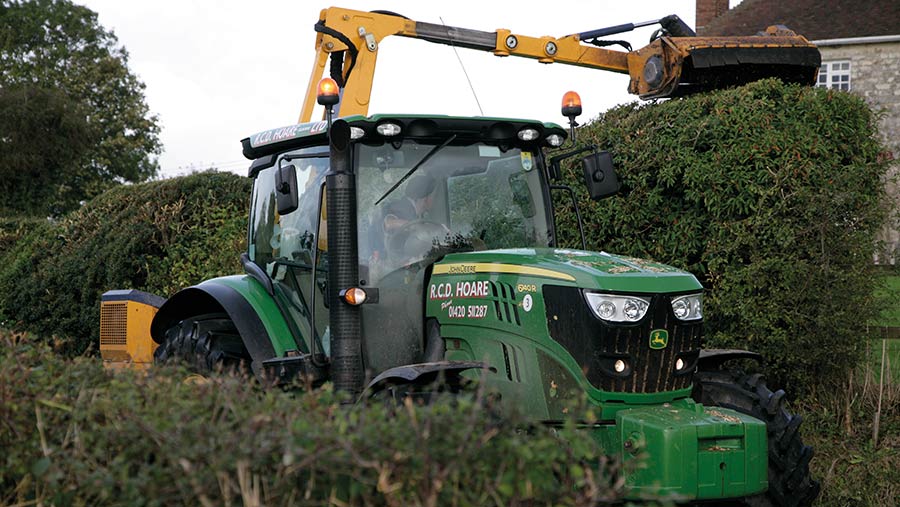 © Andrew Faulkner
© Andrew Faulkner Hampshire contractor RCD Hoare gives us the lowdown on the assorted kit lurking in the family firm’s machinery sheds.
Find out what the most reliable starter is on the farm and whether John Deere or New Holland tractors have stolen their hearts.
See also: See also: On test: John Deere’s 6R 185 tractor
Farm facts – RCD Hoare, Alton, Hampshire
- Farm size 16ha owned, 105ha rented
- Cropping All grass, mainly for hay
- Stock Sheep grazed under licence
- Contracting 15,000 grass bales/year, 20,000 straw bales/year, 1,200ha forage harvesting (grass/maize), hedgecutting, muckspreading, arable cultivations
- Staff Eight full-time (including family members) plus seasonal casuals
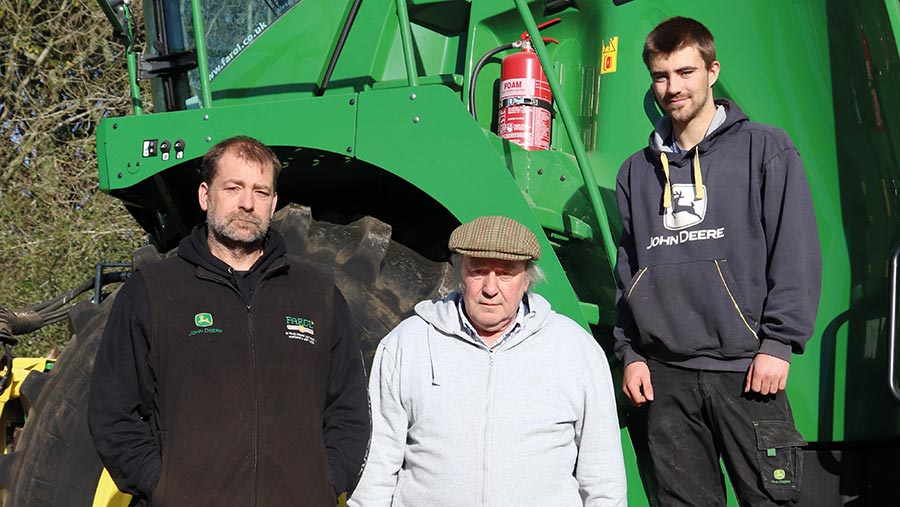
Shane, Richard, and Max Hoare © Andrew Faulkner
How did you get started?
Richard Hoare: I started out in 1973 with a couple of Fordson Majors.
Through the winter I’d set up one Major on the saw bench first thing in the morning and leave my wife, Jenny, to get on with the logging. Then I’d head off ploughing with the other Major.
We also ran a Ford 13-Six backhoe, which I bought second-hand for £1,100 – at the time, it was about the same price as a new Ford Capri.
The digger allowed us to take on all sorts of jobs, from estate work all the way through to gravedigging; we had contracts with several cemeteries in the area.
In the 1980s we took over a drainage company, Deane Brothers (Liss), which got us into land drainage and clearance. And then in the 1990s I bought my first big baler, a red/yellow New Holland D1000.
Shane Hoare: I joined the business in the late-1980s when father moved into mainstream contracting.
Today, the focus is on forage harvesting, baling, hedgecutting and muckspreading, but we still do a fair amount of estate work through the winter. Three out of the four 360s are fitted with tree shears.
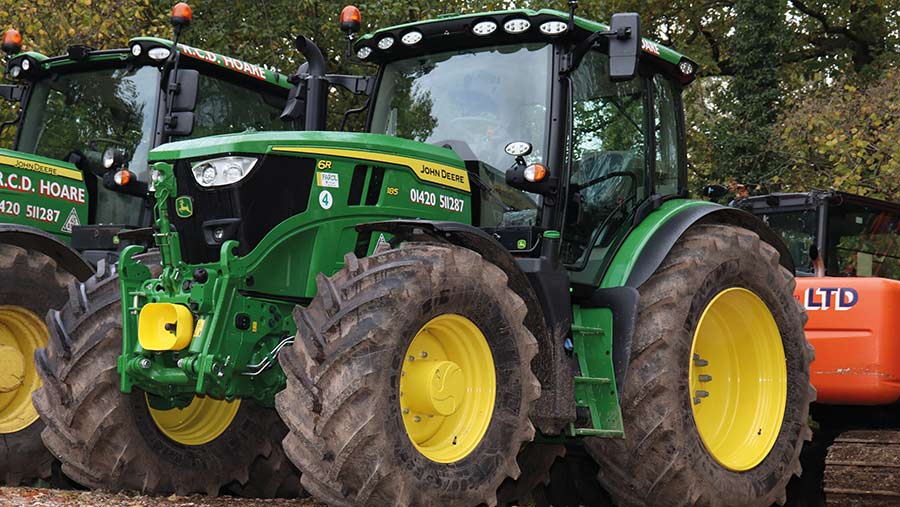
A pair of 6R 185s are the latest additions to the all-Deere tractor fleet © Andrew Faulkner
How brand loyal are you?
Very. We operated New Holland tractors for about 30 years, but then switched to John Deere in 2005. And we’ve stuck with green and yellow pretty much ever since.
We briefly tried the likes of Fendt, Valtra, Case IH and Deutz. However, we’ve always ended up back with Deere. The drivers like them, they’re reliable, we get good back-up and they hold their money.
You never have trouble selling a Deere, especially if you spec them up when new. As an example, we always tend to fit front linkages, as this helps at resale time.
It’s much the same for Krone grass kit. Again, it’s well-built, reliable and easy to sell on.
Favourite dealer?
Farol for John Deere and Mike Garwood for implements and parts. Many dealers now fill their shelves with toys and merchandise rather than items you actually need. Not Garwoods, though.
We were amazed earlier this year to find they had a starter switch in stock for the old Fordson Major.
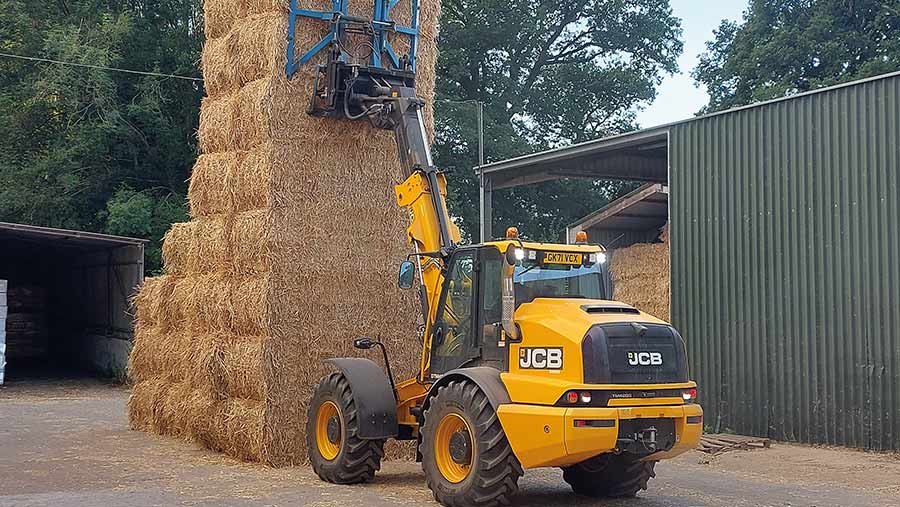
TM420S has become a driver favourite with the Hoare team © Andrew Faulkner
Favourite piece of kit?
Shane: Either the Big Bale Transtacker or JCB TM420S. The 16-bale (120x90cm) Transtacker has transformed our bale carting operation, halving the number of tractors and loaders required.
In the past we’d have run two loaders — one in the field and one in the shed — plus three or four tractors and trailers on a short haul, whereas we can now manage the same daily output with just the Transtacker and one loader back at the shed.
We can comfortably shift 600-700 bales/day like this.
The TM420S pivot-steer loader is another favourite. It’s much lighter, more manoeuvrable and versatile than the 418 Farm Master it replaced. And it’s just as capable on the silage clamp with a 12ft folding fork.
Richard: For me, it would have to be the old County tractors. In the past we’ve had 1184s, 1174s, 1164s and 1124s, and nothing would beat them.
Least favourite piece of kit?
We don’t really have one. If we don’t like a machine, we’ve never been too worried about getting rid of it.
Latest purchase?
Two John Deere 6R 185s, which replaced a 6195R and a 6130R. We tried a Fendt 724, but, despite being rated at about 50hp more than the 185s, it didn’t massively outperform them.
On top of that, the deal would have cost another £50,000.
On the mowers, balers and trailers, we’re looking for extra power rather than weight. So, for us the 6R 185s are ideal.
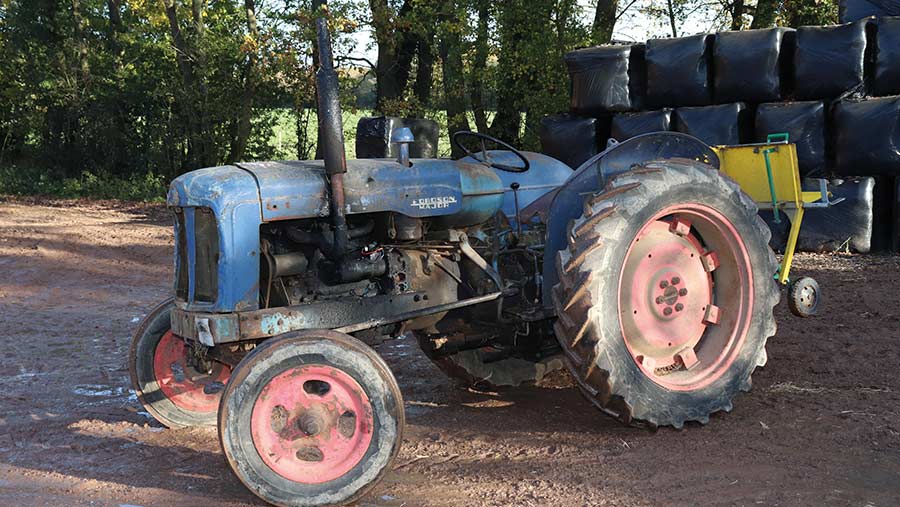
60-year-old Fordson Major © Andrew Faulkner
Oldest machine still at work?
Shane: Other than Dad, that’ll be the 60-year-old Fordson Major. It still runs a saw bench and Riko 22t splitter, and it’s one of the most reliable starters on the place.
How long do you keep your machines?
There’s no fixed policy. The tractors used to be on a two-year cycle, but that was when they were doing more work. Plus, given all the recent price increases, there’s now the additional up
front cost to consider. Even though residual values are currently strong, we’ve stretched the tractor cycle to five years, and it’s the same for the forager.
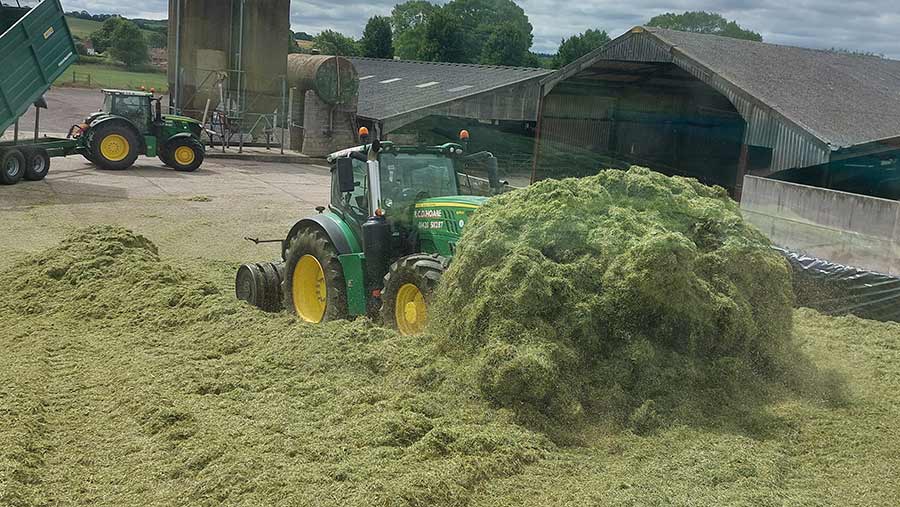
© Andrew Faulkner
Next on your wish list?
Probably a pipe dream, but it’s an air-conditioned workshop. Fixing machines in last summer’s 35C heat was tough.
Biggest machinery mistake?
A 9m Kramer KT559 telehandler. It replaced a 9.5m JCB for stacking bales, but it turned out that the Kramer’s two-section boom only effectively lifted to about 8.5m.
Not only that, but the machine was long, weighed almost 12t and felt underpowered.
We quickly shopped it in for a JCB 535-140, which measures about the same size physically yet lifts to 14m. We get on fine with the smaller Kramer, a KT407.
Most expensive repair bill?
Tyres are a huge cost. We had a 7310R that clipped a stone wall by the side of the road and took a chunk out of both offside front and rear rubber. As the tyres were already 30% worn we had to replace all four.
The quote from Michelin was about £12,000, so we went for BKTs at less than half the price. Ever since, we’ve been big fans of BKT.
On other major repairs we’ve been lucky.
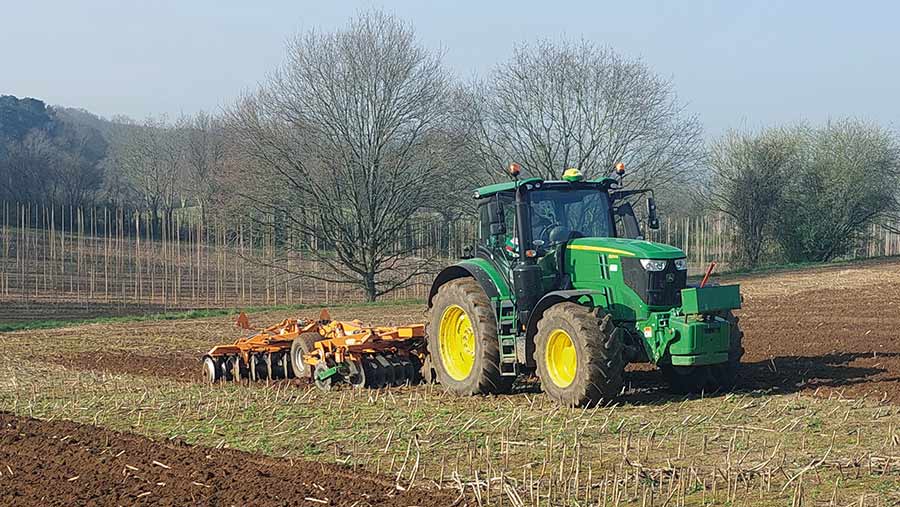
© Andrew Faulkner
Most expensive spare part?
Tractor wing mirrors are the current sore point. At more than £100 a pop, a John Deere mirror glass seems massively overpriced, and the bill for the complete electrically controlled unit is eye-watering.
We now fit metal mirror guards (£100-£120), which don’t completely solve the problem, but do save on the more minor knocks.
Best invention?
More of a mod than an invention, my recent favourite is a home-built Q-fit adapter plate that allows the 360s to operate the telehandler attachments.
As an example, we’ll often use a 360 to unload wrapped silage bales from the trailers.
What couldn’t you live without in the farm workshop?
The mig welder, without a doubt. It’s used every day. We’ve also got a decent selection of Milwaukee power tools.
Favourite and least favourite jobs?
Favourite is on one of the tree shears. It’s a skilled job, and there’s always something to think about if you’re doing it right and safely. It’s also satisfying to see what you’ve achieved at the end of a day.
Least favourite is probably repairing a plastered muckspreader in the field. It’s generally a snapped bed chain or burst pipe.
What’s your everyday farm transport?
A 17-plate Ford Ranger double-cab, which replaced a Nissan Navara with a blown head gasket. The Ranger was bought ex-lease for £19,000 a couple of years ago with 26,000 miles, and it’s now up to 54,000 miles. I love it.
It’s comfortable, has been no trouble and will average mid-30s mpg on a long run. It’s down in the mid to low 20s around the lanes, though.
Best tractor you’ve had?
Probably a 16-plate, 9,500-hour John Deere 6155R AutoPowr. We had it from new and only ever put tyres on it. It was bought for about £75,000 and sold for £45,000. In terms of cost per hour, that’s cheap.
Worst tractor you’ve had?
Without doubt, a New Holland TM190. We had a pre-production model for a year and lost around 600 hours in breakdown time.
Everything went wrong on it – steering, brakes, transmission. It was so bad that New Holland replaced it after 12 months, although the new one wasn’t much better.
To be fair, the smaller TMs were decent tractors. However, the long-wheelbase TMs, in our experience, were a nightmare.
Biggest machinery bargain?
We bought a Genie cherry picker off eBay for £4,000 as almost an impulse buy; a new one is more than £20,000. We used it a lot before it was sadly destroyed in a customer’s barn fire.
Kit list
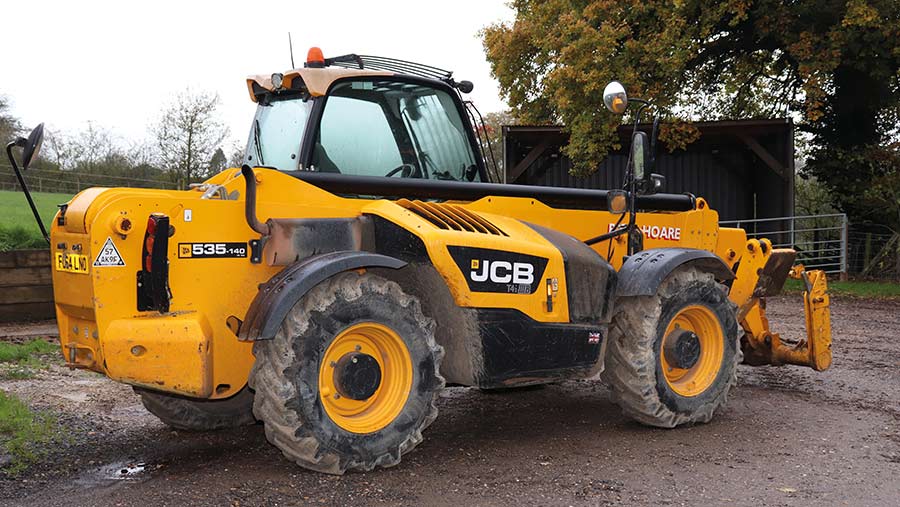
JCB 535-14 © Andrew Faulkner
- Tractors John Deere 6250R, 6195R x2, 6R 185 x2, 6175R, 6155R, 6135R, 6130 (with loader)
- Forager John Deere 8400i
- Balers MF 2170, Claas Quadrant 5300, Hesston 4755, John Deere 1433, McHale Fusion 3 baler wrapper
- Grass kit Claas Cargos silage wagon, Krone triple mower combi, Krone front/rear combi, Krone Swadro 1400 four-rotor rake, Krone Swadro 880 two-rotor rake, Krone Swadro 760 two-rotor rake, Krone 11.22 and 8.82 tedders
- Arable kit Kuhn six-furrow plough, 3m Simba Solo, 6m Kuhn power harrow, 3m Kuhn/Lely power harrow drill combi, 4m Kuhn/Lely power harrow/drill, eight-row Gaspardo maize drill
- Loaders JCB TM420S pivot-steer, JCB Loadall 535-140, Kramer KT407
- Excavators Hitachi Zaxis x4 (1.7t, 6t, 13t and 21t), three with tree shears
- Muckspreaders Shelbourne Reynolds Powerspread x2, Teagle Titan 12 rear-discharge x2, Rolland 11t rear-discharge
- Hedgecutters Bomford 7m, McConnel 7m x2, Bomford 6.5m x2
- Other kit Big Bale Transtacker bale stacker, various trailers, Teagle front flail mower, McConnel 6m rotary mower, Major 2600 slurry tanker
